

Catch Fish with
Mike Ladle
Information Page
SEA FISHING
For anyone unfamiliar with the site always check the FRESHWATER, SALTWATER and TACK-TICS pages. The Saltwater page now extends back as a record of over several years of (mostly) sea fishing and may be a useful guide as to when to fish. The Freshwater stuff is also up to date now. I keep adding to both. These pages are effectively my diary and the latest will usually be about fishing in the previous day or two. As you see I also add the odd piece from my friends and correspondents if I've not been doing much. The Tactics pages which are chiefly 'how I do it' plus a bit of science are also updated regularly and (I think) worth a read (the earlier ones are mostly tackle and 'how to do it' stuff).
Lure fishing in the 2020s - Part III
THE PREDATOR
The Dinner Gong
Predatory fish can be considered to hunt in a series of stages. Firstly, as already mentioned, they must locate the prey. Having, found out where it is, they must then recognise it as a suitable meal.
So, how does a predator decide that something is appropriate to eat? Size must be the most important consideration. Sometimes, when a fish is landed it is obvious what it has been eating. As the hooks are removed from the jaws of bass or pollack they occasionally 'cough-up' masses of sandeels, some of them still alive. I have landed pike with the tails of roach or dace protruding from the throat, and trout as they bounced about on the grassy river-bank have coughed out minnows or bullheads. In such cases it is easy to decide the size of the prey that they were eating, but these are exceptions.
Usually, it is necessary to base judgements on what we know about the habits of the fish we are after. It would be impossible to deal with every species of fish, even if the information were available, but are there any general rules? First consider the size of the predator and in particular the gape of its open mouth, this should give you a clue. Smaller species, such as perch, trout, or mackerel, will generally feed on smaller animals than those eaten by, for example, pike or cod. As a rule, the larger specimens of any species will eat larger prey than their little brothers and sisters; and they will take correspondingly larger lures. For maximum sport (number of bites), a lure well within the size range of prey being eaten will be best. A larger lure will generally induce fewer bites; on the other hand, it may give a better chance of an exceptionally large specimen. So, ‘big baits for big fish’ is a sound idea, if that's what you would like to catch. Occasionally, an 'unusually bulky' or 'smaller-than-usual' lure will produce a bite or two from fish that are already stuffed with food, but this is a last resort.
Big Lures for Big Fish
Perhaps one of the most striking examples of the big bait/big fish relationship was encountered by Harry when he was working in Zambia, Africa. Because his outward journey was encumbered with the entire families’ luggage most of his fishing tackle had to stay at home; but he found room for a ‘light beach-caster, a fixed spool reel and a few 'spinners'.
The first revelation came when he visited the local tackle shop in Lusaka. Most of the gear on sale was of American origin. The ‘spinning’ rods were almost all short, whippy, wands, totally foreign to his experience. Eventually he found one with a stiffish action and was told that he could ‘have it cheap’ because it was quite unsuitable for spinning. Money exchanged hands and he became the possessor of a rod which he used for many years, all round the World.
The lures on sale in Lusaka were mostly familiar plugs and spoons from the U.S.A. but some of the most exciting items were the locally sourced and evocatively named 'Zambesi Spinners'; huge spoons up to fifteen cm long, each with a single, long-shanked, wide-gaped, very strong hook. They resembled massive ‘fly -spoons’, with the hook brazed to a swivel on the concave face of the spoon, and they were coloured in combinations of red, copper and silver. Harry was told that expert ‘tigerfish anglers’ often altered the properties and action of the spoons by adding solder to the inner face. Even more impressive were the crude but enormous plugs, many of them larger than the average British chub or trout. “What are they for?” he said, feeling rather foolish. “Nile Perch” came the reply. He selected a couple of hefty specimens, weighed them in his hand and felt thankful that he had brought the beach-caster with him.
Typical lures from Lusaka compared to the familiar eleven cm Rapala. The big spoon is a tigerfish lure.
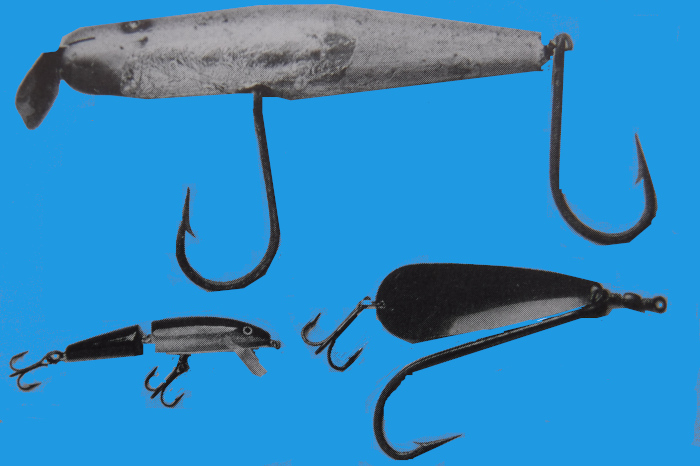
A small tigerfish for me on a trip to Lake Nasser. I was lucky to hook it on the little plug - those teeth can do some damage.
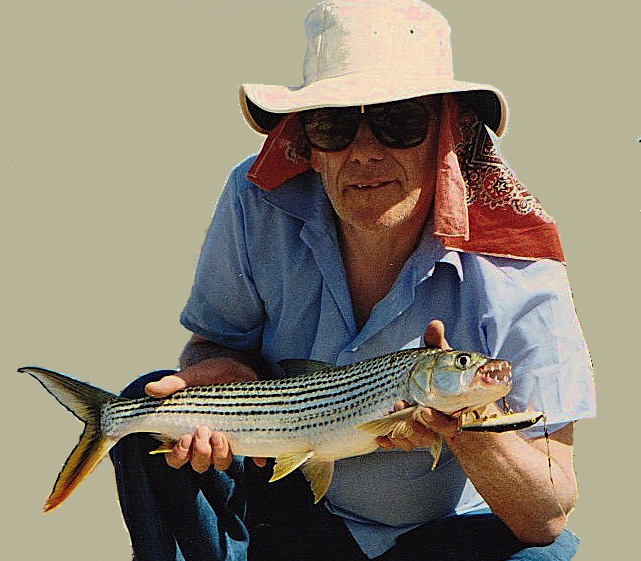
What fine teeth you have
At every opportunity after buying the gear, Harry was wielding his tackle on the shores of a lake or river. His prime target was the fabulous tigerfish, deep bodied and brassy scaled, with a series of dark lines running along each flank. The most striking feature of this fish are the incredibly long and sharply pointed teeth which ornament the powerfully muscled and bony jaws. This dental equipment is used to disable large prey-fish by chopping off fins or removing chunks of flesh. Due to this method of attack, if chewed and broken line is to be avoided, lures must be protected by a length of wire trace . Bright, flashy swivels or clips, joining the trace to the main line, are not recommended as they are likely to induce bite-offs.
As I found some years later on trips to Lake Nasser in Egypt, the mouth-lining of tigerfish is a bit like a Teflon pan; this makes it very difficult to set the hook anywhere except into the internal nostril or the ‘scissors’. Hence the large hooks on tailor-made lures. This problem is magnified by the fantastic vitality of the fish which often come adrift as they hurl themselves into the air after a strike.
Harry’s first success from the shore of Lake Kariba resulted in 3 kg 'tiger' taken on a big spoon. His pride was somewhat deflated when a colleague informed him that it was “…hardly worth keeping.” The record for the lake at that time was almost nineteen kg – a real dream (or nightmare) of a fish.
Size matters - but it’s not the only thing
Apart from the size of the prey there are several other things to be taken into account. There were a number of lessons to be learned on the African lakes. Harry put in a good deal of effort spinning from a small boat for the elusive Nile perch. On one occasion he was thrilled to find the sort of activity which shouts out "fish!" A huge Shoal of sardine-like kapenta were under assault by larger predators. Over a wide area the little silver fish were spraying from the water, and the heads, tails, and fins of their aggressors were breaking the surface everywhere.
The boat was drifted through the area of activity, and a Toby, of appropriate size to the bait-fish, was cast out and retrieved repeatedly, without so much as a sniff. At the other side of the shoal, after a six-hundred m drift, Harry change the lure, motored back up well clear of the fish, and began a second drift. Once again, the lack of action was impressive. For a third time the drift was repeated, this time with a white, red-headed plug but with no greater effect. Still the predators were feeding in a frenzied fashion all around the boat. It was almost unbelievable. Quite suddenly the Shoals dispersed, and Harry was left to contemplate his failure. What had he done wrong? Why did the fish ignore his lure? The size and action of the spoon lures had resembled the prey fish as closely seemed possible and they must have been seen by countless predators.
Later, he asked a fishery biologist how many kapenta would be in a school of the size which he had seen, and was told that it could have been as many as half-a-million, depending on the depth to which they were swimming. It seemed to Harry that his failure may have been due to the old reason - the availability of too much natural food. The chance of a predator selecting his lure from the host of sardines was probably quite small - a masterly understatement.
On the next occasion that he saw a similar phenomenon it was on a much smaller scale. This time he was more patient and watched the pattern of movement shown by the rolling predator's (always a good idea). They were mostly active near the surface around the edges of the sardine school. This time the Toby was cast only to the margins of the area of activity and he had fine sport with Nile perch of up to five to six kg. As it turns out this was an object lesson in the reason for defensive schooling by small prey fish.
A 'small', lure-caught, Nile perch on one of my trips to Lake Nasser.
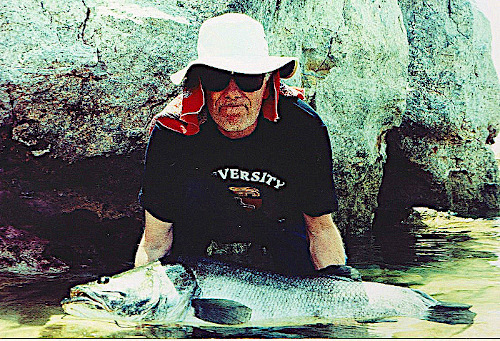
Shoaling for safety
Many small forage-fish for form schools for purposes of defence. All the fish in a school will accelerate, and will turn and slow down almost as one, with never a bump nor jostle. Just like a flight of birds, they are able to perform these high-speed manoeuvres by reacting to the movement of their nearest neighbours. As a rule, shoaling fish keep in touch with each other by vision, and avoid collisions by using the lateral line sense to keep them apart. Fish gathered into tight groups are less likely to encounter wandering predators than are lots of scattered individuals. Also, many pairs of eyes may be better than one when it comes to detecting the approach of a killer. In addition, a hunter which needs to 'track and line up' its prey could well have problems selecting a target from the bobbing weaving school and the assailant might easily be distracted into a series of tiring chases involving one fish after another, each new chase giving the other potential victims a bit of a breather.
Bait-fish schooling for defence; behaviour which seems to work in both fresh- and salt-water.
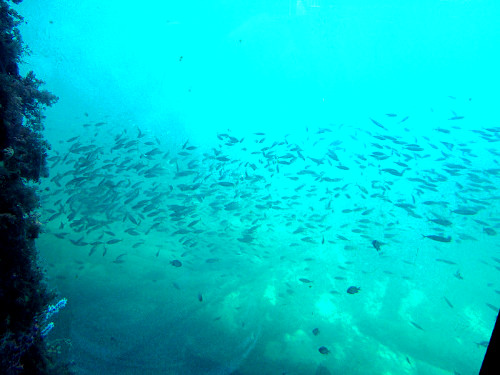
It has been shown conclusively that predators, both in fresh waters and in the sea, will soon pick out members of a school which -
1 Look slightly different.
2 Behave erratically.
3 Become separated from the main group of fish.
In the light of these facts, Harry’s failure to get bites can be explained (or at least has an excuse).
One or two other aspects of the 'kapenta/Nile perch' story are of interest. The commercial fisherman of Lake Tanganyika, in answer to Harry's queries, said that the kapenta spent most of the hours of daylight at depths of up to seventy m. At night they migrated up to the surface. Presumably, the fish which Harry had seen were driven up by an attack from below. Of the three species of Nile perch present in the Lake Harry had, of course, been catching the smallest. The largest type, which attains about one-hundred kg, may be caught at depths of over two-hundred m. At this weight it might be said that the danger lay in the fish catching Harry.
Before any of this information could be acted on it was the end of the year, and Harry and his family returned home. However, many of his observations on huge tropical lakes and rivers have their parallels in and around Britain.
Keeping in shape
Our own pike has received more than its fair share of study. Pike feed selectively, that is to say they have been shown to prefer certain sizes and species of fish as food. Young pike, of about twenty-five cm in length, prefer prey of about 4 cm long, fish of forty-five cm have a preferred prey size of 8 cm while larger pike will choose correspondingly larger victims. Another very important aspect of size, is that big baits can be seen by hungry fish at greater distances than small ones. So, all things being equal, a big bait is more likely to attract the attentions of a predator then a small one.
Large pike prefer to eat bigger fish than do their smaller relatives. This one went slightly over-the-top.
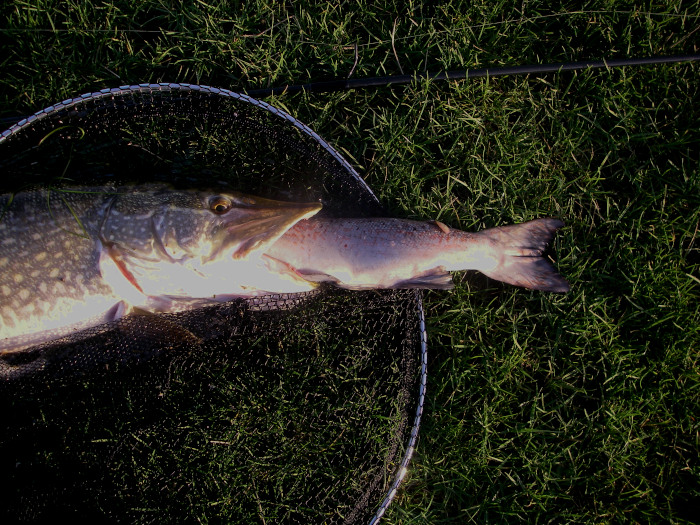
Of course, size of prey is only one feature among many. The next obvious thing for the lure fishermen to take into account is the shape of the common food items. Are they thin or fat, slimline or deep bodied? There is probably not much point in looking for an exact imitation and, as long as your lure is roughly the right shape, most predators do not seem to be particularly fussy. Pike, which are used to feeding on, for example, bream, will be on the look-out for fish about three times as long as they are deep. Bass, which are searching along wrack covered ledges for wrasse, are also likely to be switched on by a meaty mouthful. In contrast, sea trout, pollack or mackerel with sand eels on their mind, will have a fixation for fish about eight times as long as they are deep. The lure should be chosen accordingly. Prawns and squid will create a roughly conical or wedge-shaped search image. Crayfish or squat lobsters may produce an overriding impression of trailing pincers or dangling legs. If trout fly-anglers have shown it to be worthwhile to make each tiny imitation closely represent a certain insect (I have to say that I’m not convinced that this is the case), then it could be even more important to match the form of a decent square meal. Shape clearly does matter as it has been shown that crucian carp develop a deeper body shape in the presence of pike. Presumably being a bit fatter (deeper) in the body means that only the larger pike will think of them as a tasty morsel.
It may be best if your lure mimics the shape of natural prey items.
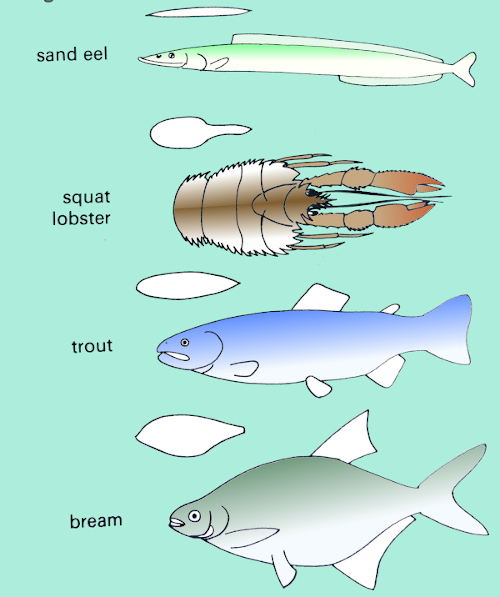
Movement
Taking another leaf out of the fly angler’s book, movement is a key factor in prey recognition. Fish detect the movement of their chosen prey in two ways - by vision and by sensing vibrations (waves) through the lateral line system. Pike, for example, have many vibration sensors around the head – just where they are needed for search and destroy activities. The brain of the predator analyses this information and decides whether the swimming-speed, flicker-rate and throb-signal say 1. food? 2. appropriate food? 3. vulnerable food? If all three answers are acceptable the fish may go into attack mode.
Movements, like sizes and shapes, are generally characteristic of each type of prey: for example, some bait animals will swim quickly and others slowly. Small fish will generally flicker or vibrate at high frequencies, say several times per second; larger specimens will wriggle along at a slower pulsing rate. Small fry and sprats seemed to twinkle through the water while eels and lampreys move with sedate undulations. The key-feature of most healthy, swimming animals is a regular rhythm. Predators respond quickly to any slight deviation from the normal, and prey creatures which have lost their rhythmic swimming pattern are often as good as dead. Think of how lions or wolves carefully select the young, old or weakened prey before attacking.
The value of colour
The easiest thing for a lure manufacturer to change, and the one most likely to ‘catch the eye’ of the angler searching the tackle catalogues, is colour. Consequently, many modern lures are printed to look more like real fish than real fish. An even greater number of lures resemble nothing that ever lived or swam. In practice colour is probably of less importance when it comes to predators searching for a meal.
Colour in fish has several important functions, the most familiar one being camouflage, which is generally achieved in one of two ways. The many silver-sided, counter-shaded fish - such as sprats, sandeels, roach, dace, seatrout, salmon and so on - are trying to disappear by reflecting their surroundings. Think of the illusion created by the mirror at the back of a supermarket display if you want to get the idea. Also, by reflecting every scrap of light they will merge into even a well-lit background.
Many small bait-fish which swim in open water have 'mirror' camouflage.
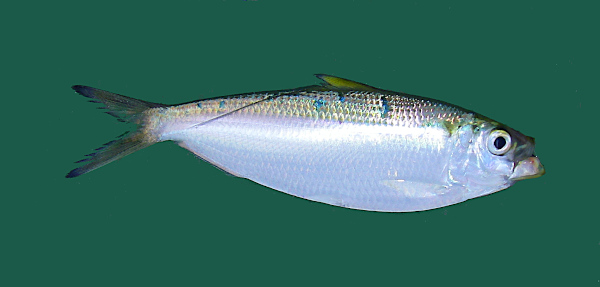
A second form of camouflage is simply that of matching and merging into the surroundings. Fish may change the colours and patterns on their skin to achieve this. Flatfish are particularly good at colour change (much quicker than the fabled chameleon), but most bottom living or weed haunting species of fish can do the same sort of thing.
A plug-caught flatfish shows typical sea-bed camouflage of these fish.
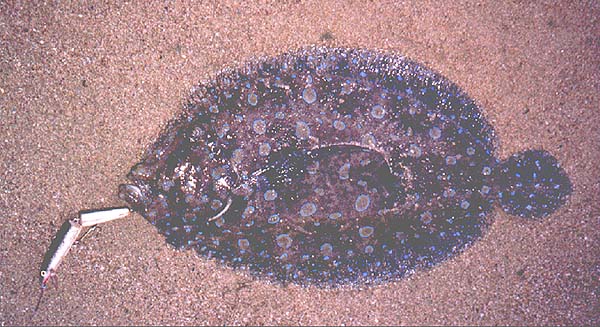
No camouflage is perfect, and the give-away for the silver camouflage is usually when it catches the light and flashes, or sometimes the contrasting eyes, which they are unable to silver effectively, give away their presence. For the bottom living forms, mismatching of colours and patterns is the problem; this results from either being the correct colour on the wrong background or vice versa. If colour was not so important in concealment, then fish, cuttlefish and other potential prey would not have evolved such impressive colour change abilities.
The awkward shape and brilliant silver sides of a lookdown may both reduce predation, but note the dark eyes.
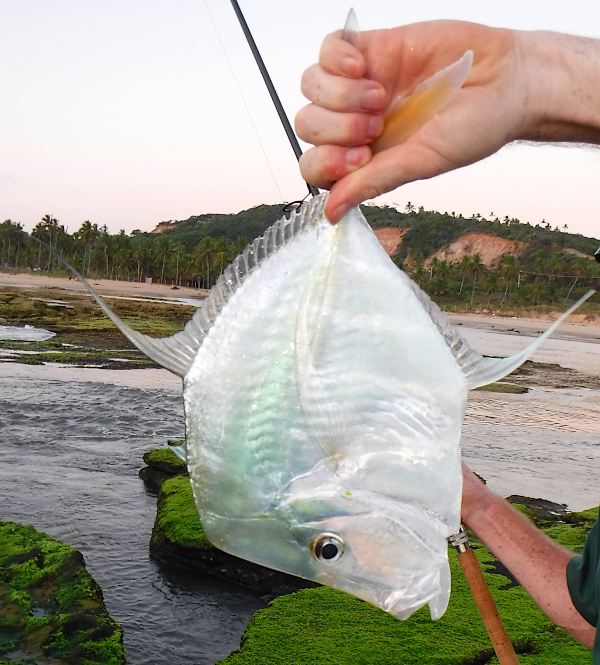
The keen lure-fishermen should always bear in mind that not all colours are likely to be attractive to predators. Just as Wasps have black and yellow bands, and distasteful or poisonous butterflies often have bright bold colour patterns, so there are warning colours underwater. Very strongly coloured, conspicuous lures may actually scare or deter predators; and there are good examples of black fins in poisonous fish such as weever's; large, black eye-spots in cuttlefish, etc. There are also bold stripes, spots and colour patterns in certain wrasses and other cleaner-fish which may well be keep-off or leave-me-alone signs. Since most colours are quickly absorbed as light passes through the water; warning colours are only likely to be effective in shallow, clear, well-lit places.
Puffer fish and their relatives are weak swimmers and are sometimes highly poisonous. Perhaps these are warning colours?
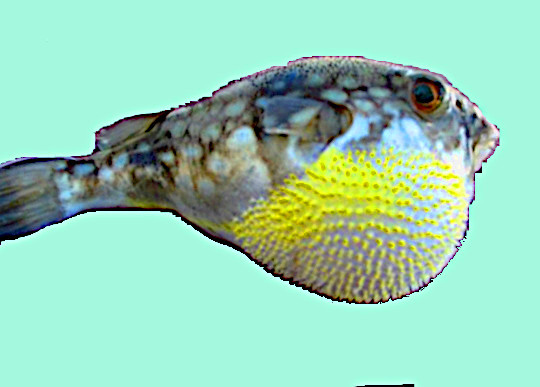
An interesting additional aspect of colour is the combination of bright silver flanks and poisonous fin spines in some common marine catfish and a few other species such as the ‘leatherjacket’. It is possible that these fish have patterns of behaviour which display their dangerous nature to potential predators. Scientific studies have shown that young grunts, which are not poisonous, mimic leatherjackets which have poisonous spines in the dorsal and anal fins.
The leatherjacket is just about as silver as they come but has poisonous fin spines. Some young non-venomous grunts mimic it (for defence?)
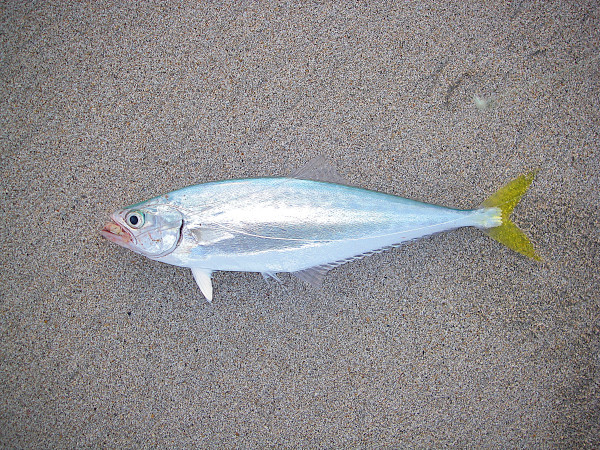
The easy option
The balance between expending energy in catching prey and replacing that energy from the food eaten is a matter of life and death by starvation; so most predatory fish will go for the easiest option. Think of them as being ‘lazy’ or 'playing the percentages'. For example, pike have been shown to eat those fish which are most abundant and therefore easiest to come by. In Lake Michigan the pike switched from eating smelt to eating shad, as their preferred prey, when the latter migrated inshore to spawn in May to August. The significant thing is that the pike completely ignored the abundant perch, a species which they usually devour with relish, because they had become preoccupied with either smelt or shad. The same sort of switching and preoccupation has been shown to occur in zander and smallmouth bass and is, no doubt, widespread.
Many of the studies on prey selection have been carried out with largemouth bass. These voracious, perch-like fish of the North American continent have pretty broad tastes. In a couple of private ponds near my home in Dorset, we used (in the 1960s and 70s) to catch quite a few introduced largemouths on a wide range of baits and lures. The fish would come up and inspect any object in or on the water, and quite often the float in use for tench or roach would be nosed with a view to consumption as food. After a close examination the bass usually melted away into the brown, clay-stained water, but occasionally, if the float was twitched, it would be taken with a gulp. Despite their relatively huge mouths, these fish are, in fact, rather fussy and have definite preferences for particular types of prey. In one experiment it was shown that largemouths preferred ‘dace’ and newts to golden-shiners and right at the bottom of the menu were domestic goldfish. The conclusion was that the bass chose their food on the basis of:
1. Its size.
2. The way in which it behaved.
3. How easy it was to catch.
4. Its taste (palatability).
So, the general picture is clear; a decent lure must look and move like a favourite prey. Its size, shape, speed and rhythmic swimming movements have to be of the right kind – but, in addition, the lure must signal its vulnerability:
1. By being separated from its fellow shoal mates.
2. By moving a bit more erratically, jerkily or slower than normal.
3. By travelling in an unusual direction.
4. By standing out from the background (being slightly off-colour?).
A few examples of the right food doing the wrong thing may not come amiss. Any fish on its own, in other words, separated from its shoal-mates can be a target. Predators will generally select a fish which is an outlier. Similarly, a fish which looks as though it might have a bit of a ‘limp’ or be otherwise disabled is guaranteed to draw the attention of predators. So, it is best to cast your lure so that it will pass round the edges of the baitfish shoals and to retrieve it a little slowly or erratically.
Since the hunting, predatory fish will expect to encounter its prey heading for cover; cover being the weeds, rocks, pier piles, sandy sea- or river-bed, the water surface or the protection of the shoal: a lump of food (=lure) heading in the opposite direction will be asking for trouble.
Many small fish and other creatures will do their utmost not to look like food. I have often seen small rudd hanging motionless, heads down, in the calm, clear, still water of lakes. This posture might well be suicidal if it were recognised by hunting pike, perch, or zander, but presumably it is safer than swimming about in a normal fashion. Bass in the sea will often ignore a stiff, gently-sinking prawn, only attacking when the crustacean flicks its tail fan and tries to escape. It seems that the rigid prawn either does not look like food or possibly seems to be a tricky mouthful, with its sharp, sawtooth rostrum sticking out like a spear. The movement makes it irresistible.
For out and out predators such as pike, erratic movements of prey fish are like a dinner gong. Takes can be induced by twitching a lure or by fishing it sink-and-draw in front of a well known or suspected lie. Many territorial fish, including salmon, will also respond to a plug, spoon or spinner twitched or dabbled ‘on their nose’. The repeated jerky movements may suggest the presence of a school of prey animals. This can actually stimulate feeding or simply catch the predator’s attention, allowing it to anticipate the chance of a successful strike.
You can't fool a skipjack
A single angler or even a few pals who exchange information, rarely catch enough fish to provide sound evidence to show that one particular lure (or bait is) better than another. However, thousands of examples of whether a prey fish ‘Looks Right’ are recorded in the catches of the pole-and-line tuna fishery. The importance of the ground-bait effect, produced by the presence of schools of forage fish, is well known to the commercial fishermen. In the Hawaiian tuna fishery, the fast-swimming skipjack tuna are caught on hook,‘rod’ and fixed-line (no reel). Live fish are used to bait the hooks, and the fishermen go to great pains to catch small fish (nehu) for bait. The bait-fish are a type of plankton-feeding anchovy and are kept alive in specially constructed live-bait wells within the fishing boats.
The little nehu - a type of anchovy is top of the menu for skipjack tuna.
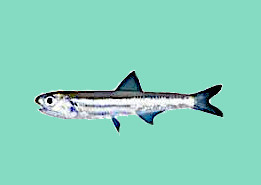
Just like any other anglers, quite often, when the tuna-fishermen need bait most, it is hardest to come by. Remember that pike session when the dace refused to bite? or when the seatrout were clearly active, but you couldn’t catch a minnow to save your life? or the turbot fishing charter trip when the mackerel did not cooperate? (I do). To make up for this problem an attempt was made to breed and supply tuna live-bait, in large quantities, at a low price; the most convenient fish to farm for bait was the African tilapia. These were reared in freshwater ponds and sold to the tuna fishermen.
Tilapia are easy to obtain for bait but the tuna are not so keen to eat them.
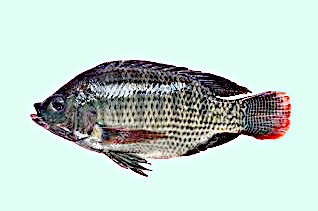
As mentioned earlier, to attract tuna and a stimulate them into a feeding frenzy the fishermen do two things. First, they play hoses on to the surface of the sea, simulating the escape activity of many small fish. Second, the little live baits are scattered into the sea by the shovel full. The hooks with their live-fish are then plonked into the midst of the frantic tuna. Tilipia resemble dull, spiky wrasse, but despite their strange appearance (nehu, which are the skipjack’s natural food look more like sprats), they were reasonably effective baits. So the tuna took them quite well but not as well as the natural food fish. The important conclusions for lure anglers were:
1. Slightly more schools of tuna were attracted by feeding with natural bait then with tilapia.
2. Natural baits (nehu) produced more fish per minute than tilapia.
3. Large skipjack tuna are more fussy (selective) than small ones.
The complete picture
To sum up, it does matter which bait or lure you use to attract and tempt a predator and, by simulating frenzied activity of small bait fish, it is possible not only to attract predatory fish to the scene but also to get them feeding.
Fish which specialise in particular prey - for example those which eat sandeels, brit, minnows and so on – develop a ‘search image’ for preferred food items and will, almost always, be tempted most effectively with a more-or-less accurate imitation of their normal food – at least in terms of size and behaviour. Generalist feeders, like pike, bass or trout may only require this approach when some particularly juicy item is exceptionally abundant. I never worry about making my lure 'stand out from the shoal' as it will never look exactly like the real thing however hard I try. Apart from these basics there are no hard and fast rules about lure selection. However, the following important details should be considered; Try to represent the natural prey at the time and place of fishing - probably in this order - when choosing a lure.
1. Size.
2. Shape.
3. Movement.
4. Position in the water.
5. Colour and Recognition Patterns are also relevant.
If it is possible to achieve most of these characteristics with your lure it will be a miracle, but even a reasonable approximation should catch fish. This is, of course, assuming - that there are predatory fish in the area; that the predators are feeding or can be induced to feed; and that the lure is not totally lost in a profusion of natural prey. In the latter case, having tried to match the chosen food and failed, it can be profitable to use a lure which is conspicuously different from the prey. This (to me) is a last desperate ‘throw of the dice’ (or lure) and if this also fails then stop spinning, make every effort to get hold of some natural baits and fish with these - always a good bet. I have spent many frustrating hours trying to catch minnows, sandeels and the like when my quarry was mad on but apparently preoccupied.
– PLEASE TELL YOUR TWITTER, FACEBOOK, EMAIL FRIENDS ABOUT THESE BOOKS.
ANGLING ON THE EDGE
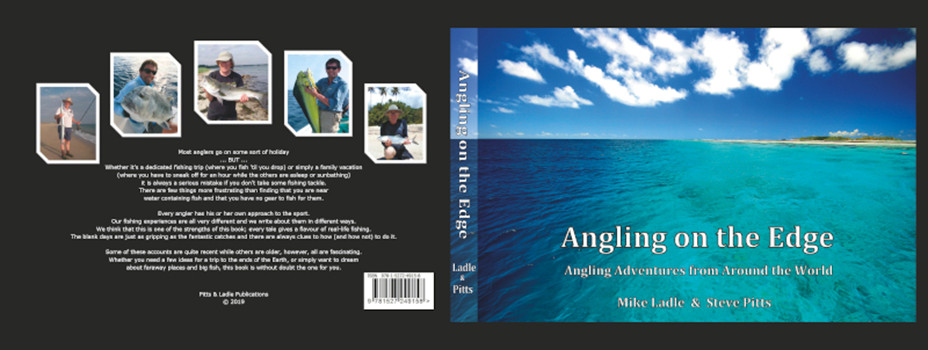
Copies can now be ordered (printed on demand) from Steve Pitts at £34.00, inc. Royal Mail Insured UK Mainland Postage.
To order a book send an E-MAIL to - stevejpitts@gmail.com
FISHING FOR GHOSTS
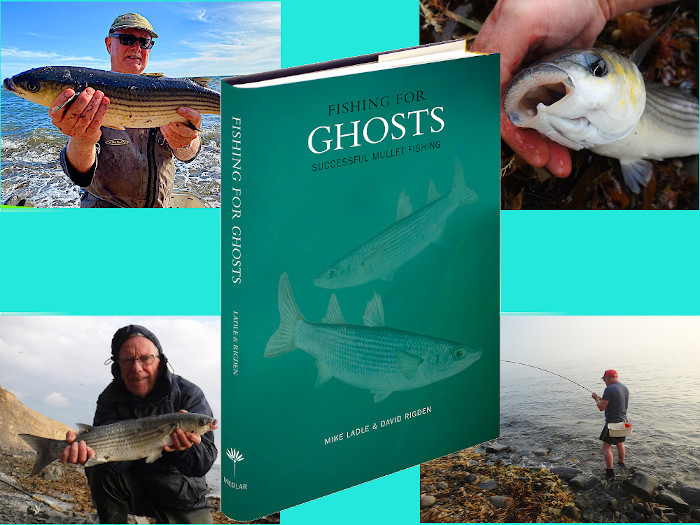
Written with David Rigden. Copies from
THE SECOND WAVE

Written with Steve Pitts this is a SEQUEL TO THE BESTSELLER "Operation Sea Angler" IT'S AVAILABLE ON PAPER FROM -
If you have any comments or questions about fish, methods, tactics or 'what have you!' get in touch with me by sending an E-MAIL to - docladle@hotmail.com